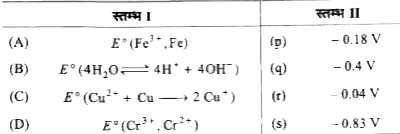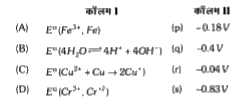(i)E∘(Cu2+,Cu)=0.34V
(ii) E∘(Cu+,Cu)=+0.52V
(iii)E∘[O2(g)+H++4e→4OH−]=+1.23V
(iv)E∘[O2(g)+2H2O+4e→4OH−]=+0.40V
(v) E∘(Cr3+,Cr)=−0.74V
(vi)E∘(Cr2+,Cr)=+0.91V
Match E∘ of the redox pair is List I with the values given in List II and select the correct answer using the code given below the lists.
![(i) E^@ (Cu^(2+),Cu)=0.34V (ii) E^@(Cu^+,Cu)=+0.52V (iii) E^@[O2(g)+H^+ +4e to 4OH^(-) ]=+1.23V (iv) E^@[O2(g) +2H2O +4e to 4OH^(-) ]=+0.40V (v) E^@ (Cr^(3+), Cr)=-0.74V (vi) E^@ (Cr^(2+), Cr)=+0.91V Match E^@ of the redox pair is List I with the values given in List II and select the correct answer using the code given below the lists.](https://d10lpgp6xz60nq.cloudfront.net/physics_images/BBP_RCM_MAC_CHE_C18_E01_019_Q01.png) Solution in Malayalam
Solution in Malayalam
P Q R S
4 1 2 3
P Q R S
2 3 4 1
P Q R S
1 2 3 4
P Q R S
3 4 1 2
D
Topper's Solved these Questions
- BOOK - BODY BOOKS PUBLICATIONCHAPTER - ELECTROMOTIVE FORCE EXERCISE - PROBLEMS50videos
ELECTROMOTIVE FORCE
- BOOK - BODY BOOKS PUBLICATIONCHAPTER - ELECTROCHEMISTRYEXERCISE - EXAMPLES134videos
ELECTROCHEMISTRY
- BOOK - BODY BOOKS PUBLICATIONCHAPTER - General Principles and Processes of Isolation of ElementsEXERCISE - Example108videos
General Principles and Processes of Isolation of Elements
Similar Questions
Calculate the reduction potentials for the following half cells:
Ag∣Ag+(10−5M),E∘Ag+,Ag=0.80V04:22View SolutionSalt bridge Is used because it_________.
03:42View SolutionThe scientific and technological process used for isolation of the metal from its ores is known as metallurgy. Name the method used for removing gangue from sulphide ores.
08:59View SolutionE^(c-) for Cr^(3+)+3e^(-) rarr Cr and Cr^(3+)+e^(-) rarr Cr^(2+) are -0.74 V and -0.40V , respectively, E^(c-) for the reaction is Cr^(+2)+2e^(-) rarr Cr
03:40View SolutionGiven: (i) Cu^(2+)+2e^(-) rarr Cu, E^(@) = 0.337 V (ii) Cu^(2+)+e^(-) rarr Cu^(+), E^(@) = 0.153 V Electrode potential, E^(@) for the reaction, Cu^(+)+e^(-) rarr Cu , will be
03:42View SolutionThe standard reduction potential data at 25∘C is given below
E∘(Fe3+,Fe2+)=+0.77V,
E∘(Fe2+,Fe)=−0.44V,
E∘(Cu2+,Cu)=+0.34V,
E∘(Cu+,Cu)=+0.52V,
E∘(O2(g)+4H++4e−→2H2O]=+1.23V
E∘[(O2(g)+2H2O+4e−→4OH−)]=+0.40V,
E∘(Cr3+,Cr)=−0.74V,
E∘(Cr2+,Cr)=−0.91V,
Match E∘ of the redox pair in List-I with the values given in List-II and select the correct answer using the code given below teh lists:
List−IList−II(P)E∘(Fe3+,Fe)(1)−0.18V(Q)E∘(4H2O⇔4H++4OH+)(2)−0.4V(R)E∘(Cu2++Cu→2Cu+)(3)−0.04V(S)E∘(Cr3+,Cr2+)(4)−0.83V
Codes:04:46View SolutionGiven the standard reduction potentials, which statement is correct?
Cu2(aq)+2e−→Cu(s)E∘=0.34V2H+(aq)+2e−→H2(g)E∘=0.0VCr3+(aq)+2e−→Cr(s)E∘=−0.73V04:53View SolutionGiven:
(i) Cu2++2e−→Cu,E∘=0.337V
(ii) Cu2++e−→Cu+,E∘=0.153V
Electrode potential, E∘ for the reaction, Cu++e−→Cu, will be06:50View Solutionदिया है
(i) Cu2++2e−→Cu, E∘=0.337V
(ii) Cu2++e−→Cu+,E∘, E∘=0.153V
अभिक्रिया Cu++e−→Cu के लिए इलेक्ट्रोड विभव E∘ होगा02:55View SolutionE^@ values for the half cell reactions are given below : Cu^(2+) + e^(-) to Cu^(+) , E^@ =0.15 V Cu^(2+) + 2e^(-) to Cu, E^@ =0.34 V What will be the E^@ of the half-cell : Cu^(+) + e^(-) to Cu ?
08:59View SolutionGiven that the standard reduction potential (E^(@)) of Cr^(3+) | Cr and Cr^(2+) |Cr are -0.74 and -0.91 V respectively. The E^(@) of Cr^(3+) |Cr^(2+) is:
08:10View SolutionGiven that the standard potentials ((E^(@))) of CU^(2+)//Cu and CU^(+)//Cu are 0.34V and 0.522V respectively , the E^(@) of CU^(2+)//CU^(+) is :
08:10View SolutionThe standard reduction potential data at 25∘C is given below
E∘(Fe3+,Fe2+)=+0.77V,
E∘(Fe2+,Fe)=−0.44V,
E∘(Cu2+,Cu)=+0.34V,
E∘(Cu+,Cu)=+0.52V,
E∘(O2(g)+4H++4e−→2H2O]=+1.23V
E∘[(O2(g)+2H2O+4e−→4OH−)]=+0.40V,
E∘(Cr3+,Cr)=−0.74V,
E∘(Cr2+,Cr)=−0.91V,
Match E∘ of the redox pair in List-I with the values given in List-II and select the correct answer using the code given below teh lists:
List−IList−II(P)E∘(Fe3+,Fe)(1)−0.18V(Q)E∘(4H2O⇔4H++4OH+)(2)−0.4V(R)E∘(Cu2++Cu→2Cu+)(3)−0.04V(S)E∘(Cr3+,Cr2+)(4)−0.83V
Codes:06:29View Solutionमानक अपचायक विभव 25∘C पर निम्नलिखित हैं
E∘(Fe3+.Fe2+)=+0.77VE∘(Fe2+/Fe)=−0.44VE∘(Cu2+/Cu)=+0.34VE∘(Cu+/Cu)=+0.52V
(E∘(O2(g)+4H++4e−→2H2O)=+1.23V,),(E∘(O2(g)+2H2O+4e−→4OH)=+0.40V),(E∘(Cr3+/Cr)=−0.74V, E∘(Cr2+/Cr)=−0.71V)
स्तम्भ I में दिए गए रेडॉक्स युग्मों को स्तम्भ II में दिए गए अपचायक विभव से सुमेलित कीजिए तथा स्तम्भ के नीचे दिए गए कोड का प्रयोग करके सही उत्तर चुनिए |
 06:29View Solution
06:29View Solutionमानक अपचायक विभव 25∘C पर निम्नलिखित है
E∘(Fe3+,Fe2+)=+0.77V
E∘(Fe2+.Fe)=−0.44V
E∘(Cu2+.Cu)=+0.34V,
E∘(Cu+.Cu)=+0.5V,
E∘(O2(g)+4H++4e−→2H2O)+1.2SV,
E∘(O2(g)+2H2O+4e−→4OH)=+0.40V
E∘(Cr3+.Cr)=−0.74V,
E∘(Cr2+.Cr)=−0.91V
कॉलम I में दिये गये रेडॉक्स युग्मों को कॉलम II में दिये गये अपचायक विभव से सुमेलित कीजिए।
 04:26View Solution
04:26View Solution

